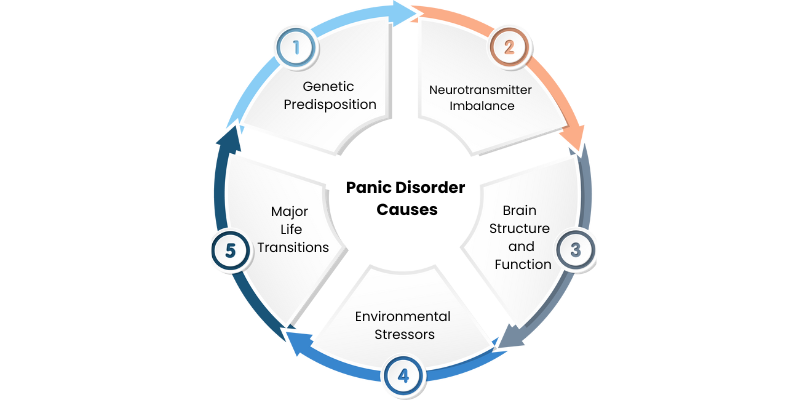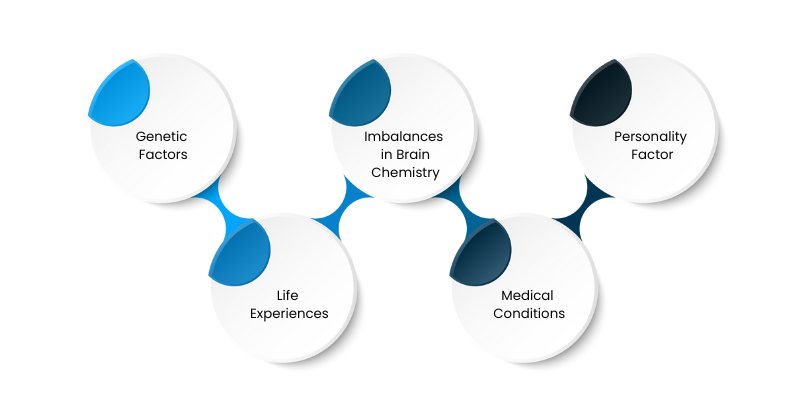
An In-Depth Look at Different Types of Moods
An In-Depth Look at Different Types of Moods Get Instant Relief Now! Mood is a fundamental aspect of human experience, encompassing a wide range of

Among anxiety disorders, the contrasting threads of Panic Disorder and Generalized Anxiety Disorder (GAD) weave distinct patterns. While both conditions share a common ground in the realm of anxiety, their manifestations and triggers set them apart. Panic Disorder manifests as sudden, intense episodes of fear, often accompanied by physical symptoms like rapid heartbeat and shortness of breath, creating a profound sense of impending doom. On the other hand, Generalized Anxiety Disorder unfolds as a persistent, chronic worry that permeates various aspects of daily life.
In this blog, we are going to explore complexities and shed light on the unique aspects of Panic Disorder and Generalized Anxiety Disorder.
Panic Disorder is a distinct facet of the anxiety spectrum, characterized by recurrent and unexpected panic attacks. These attacks are intense surges of fear or discomfort that reach a peak within minutes, accompanied by a host of physical and cognitive symptoms. The fear of future attacks can further exacerbate the condition, leading to lifestyle changes as individuals may avoid certain situations or environments to prevent a recurrence.
Individuals grappling with Panic Disorder often find themselves ensnared in the grip of distressing symptoms that extend beyond mere psychological unease. A hallmark of this disorder is the occurrence of sudden and intense panic attacks, characterized by a barrage of physical and cognitive manifestations.
These episodes, reaching a peak within minutes, may involve symptoms such as a pounding or accelerated heartbeat, chest discomfort, trembling, sweating, and a chilling fear of impending doom. It’s not uncommon for those experiencing panic attacks to feel detached from reality or have a sense of losing control.
Furthermore, the distress isn’t limited to the duration of the attack; a lingering worry about the possibility of future episodes can persist, contributing to the overall burden of Panic Disorder.
Key Symptoms of Panic Disorder:
Panic Disorder involves exploring its potential causes, which can vary from person to person. While the exact origins remain elusive, a combination of genetic, biological, and environmental factors is believed to contribute to the development of Panic Disorder.
Here are some key aspects to consider:

Genetic Predisposition: A family history of anxiety disorders may increase the likelihood of developing Panic Disorder. Genetic factors can play a role in shaping an individual’s susceptibility to heightened anxiety responses.
Neurotransmitter Imbalance: Imbalances in neurotransmitters, the chemical messengers in the brain, particularly serotonin and norepinephrine, are associated with the onset of Panic Disorder. These imbalances can influence mood regulation and contribute to the manifestation of anxiety symptoms.
Brain Structure and Function: Differences in the structure and function of certain brain regions, such as the amygdala and hippocampus, have been implicated in Panic Disorder. These areas play a crucial role in processing emotions and fear responses.
Environmental Stressors: Traumatic life events, chronic stress, or a history of childhood adversity may act as triggering factors for Panic Disorder. High-stress environments can exacerbate anxiety symptoms and contribute to the development of the disorder.
Major Life Transitions: Significant life changes, such as job loss, divorce, or the death of a loved one, can act as precipitating factors for Panic Disorder. The upheaval associated with major life transitions may trigger heightened anxiety responses in vulnerable individuals.
Understanding the multifaceted nature of Panic Disorder is a crucial step in developing effective treatment strategies and providing support to those navigating the challenges of this anxiety disorder.
Generalized Anxiety Disorder (GAD) casts a pervasive shadow over daily life, marked by chronic and excessive worry that extends beyond specific situations or events. Unlike Panic Disorder, where intense panic attacks are the focal point, GAD manifests as a persistent state of apprehension, often without a clear trigger.
Individuals grappling with GAD find their minds occupied with a myriad of concerns, ranging from health and family to work and personal relationships. The worry is disproportionate to the actual circumstance and can be challenging to control.
Living under the persistent cloud of Generalized Anxiety Disorder (GAD) entails a spectrum of symptoms that extend beyond the typical worries faced in daily life. The hallmark of GAD is excessive and uncontrollable worry about a multitude of issues, even when there is little or no apparent reason for concern.
These concerns often center around health, finances, family, work, and personal relationships. Physical manifestations include restlessness, muscle tension, irritability, and difficulty concentrating. Sleep disturbances, such as trouble falling asleep or staying asleep, are common in individuals with GAD.
The amalgamation of these symptoms creates a pervasive sense of unease, impacting both mental well-being and daily functioning.
Key Symptoms of Generalized Anxiety Disorder:
Generalized Anxiety Disorder (GAD) finds its roots in a combination of complex factors, intertwining genetics, brain chemistry, and life experiences. Understanding these causes is pivotal in comprehending the onset and development of GAD:

Genetic Factors: A familial predisposition to anxiety disorders can elevate the risk of developing GAD. Genetic influences contribute to an individual’s susceptibility to heightened anxiety responses.
Imbalances in Brain Chemistry: Disruptions in the balance of neurotransmitters, particularly serotonin and gamma-aminobutyric acid (GABA), play a role in GAD. These chemicals regulate mood and stress responses, and imbalances can lead to the manifestation of anxiety symptoms.
Personality Factors: Individuals with certain personality traits, such as being perfectionistic, overly cautious, or prone to pessimism, may be more susceptible to GAD. These traits can amplify the tendency to worry excessively.
Life Experiences: Traumatic events, chronic stress, or a history of childhood adversity can act as catalysts for GAD. Stressful life circumstances can trigger and exacerbate anxiety symptoms, shaping the course of the disorder.
Medical Conditions: Certain medical conditions, such as thyroid disorders, cardiovascular issues, or chronic pain, may be associated with the development of GAD. Addressing underlying health concerns is crucial in managing and understanding the disorder.
Exploring the causes of Generalized Anxiety Disorder provides valuable insights into its complexity, offering a foundation for tailored interventions and support for those navigating the challenges of GAD.
Exploring the differences between Panic Disorder and Generalized Anxiety Disorder (GAD) is essential for a comprehensive understanding of these distinct yet interconnected mental health challenges. While both fall under the umbrella of anxiety disorders, they differ significantly in their manifestations and triggers.
| Aspect | Panic Disorder | Generalized Anxiety Disorder (GAD) |
| Primary Symptom | Sudden, intense panic attacks | Persistent, chronic worry |
| Nature of Worry | Focused on panic attacks and fear | Broad, excessive worry about various aspects of life |
| Frequency of Attacks | Recurrent, often unpredictable episodes | Continuous, with no specific trigger |
| Physical Symptoms | Rapid heartbeat, trembling, shortness of breath | Muscle tension, restlessness, irritability |
| Impact on Daily Life | Avoidance of specific situations due to fear of panic attacks | Interference with daily activities due to constant worry |
Effective management of Panic Disorder and Generalized Anxiety Disorder (GAD) involves tailored interventions that address the unique characteristics of each condition. While both may benefit from therapies such as cognitive-behavioral therapy (CBT) and medications, there are nuanced approaches:
Treatment for Panic Disorder:
Cognitive-Behavioral Therapy (CBT): Focuses on identifying and challenging distorted thought patterns and behaviors related to panic attacks.
Medications: Antidepressants, benzodiazepines, or anti-anxiety medications may be prescribed to manage symptoms and prevent future attacks.
Lifestyle Changes: Stress management techniques, regular exercise, and adequate sleep can complement therapeutic interventions.
Treatment for Generalized Anxiety Disorder (GAD):
Cognitive-Behavioral Therapy (CBT): Targets excessive worry, teaching individuals to manage and redirect anxious thoughts.
Medications: Antidepressants, particularly selective serotonin reuptake inhibitors (SSRIs), are commonly prescribed to alleviate symptoms.
Relaxation Techniques: Practices such as deep breathing, mindfulness, and progressive muscle relaxation can help manage physical symptoms.
Lifestyle Modifications: Healthy lifestyle choices, including regular exercise, balanced nutrition, and sufficient sleep, contribute to overall well-being.
Understanding the differences between Panic Disorder and Generalized Anxiety Disorder (GAD) is pivotal for fostering empathy, awareness, and effective support. Both conditions, while falling under the umbrella of anxiety disorders, exhibit unique characteristics that necessitate tailored interventions. Recognizing the sudden, intense nature of panic attacks in Panic Disorder versus the persistent, chronic worry in GAD provides a foundation for individuals, loved ones, and healthcare professionals alike.

An In-Depth Look at Different Types of Moods Get Instant Relief Now! Mood is a fundamental aspect of human experience, encompassing a wide range of

Why Do I Feel High When I’m Not? Get Instant Relief Now! Have you ever experienced that odd sensation of feeling “high” or strangely euphoric,

Understanding How Bipolar Thinking Affects Relationships: Insights and Strategies for Support Get Instant Relief Now! Borderline Personality Disorder (BPD) is a complex mental health condition
